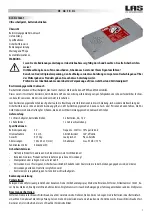
InteliGen
NT
, InteliSys
NT
, InteliMains
NT
– Troubleshooting Guide,
SW version IGS-NT-3.1.0, IM-NT-3.1.0, ©ComAp
– August 2018
9
IGS-NT Troubleshooting Guide.pdf
CAN communication does not work
Problem:
CAN communication (either via CAN1 or CAN2 interface) does not work.
Solution:
a) Check if CAN bus is properly terminated. Measure resistance between the H and L CAN
terminals when all devices connected to a CAN bus are switched off. Resistance between the
H and L should be about 60
Ω, because two 120 Ω resistors has to be used to terminate CAN
bus at the both ends of a CAN line. See
External modules connection
chapter in IGS-NT-
Installation Guide for information about CAN bus connection.
Be aware that some ComAp devices has a built in 120
Ω resistor which is connected to a CAN
bus if jumper next to a CAN interface is closed! Make sure that the terminating resistor jumper
is closed only in devices which are at the ends of a CAN line.
b) Check if each device connected to a CAN bus has a unique CAN address.
In case of the CAN 2 bus it means that
Comms settings
:
Contr. address
setpoint has to be
set to a unique number in each controller which is connected to the CAN2 bus. See
Addresses
of Modules on CAN2
chapter in Inteli Communication Guide for information about setting of
CAN addresses in ComAp communication modules and InteliVision to avoid conflict between
addresses.
In case of devices connected to the CAN 1 bus make sure that addresses are set according to
instructions which are displayed upon module configuration on the GenConfig card Modules.
On the picture is example of information which is displayed about IGS-PTM module jumpers
setting. Similar information is displayed for all extension modules.
c) Check wiring topology of the whole CAN bus cable. The topology must be linear (straight), not
“star type” and must not contain any loops.










































